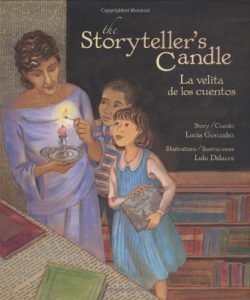 It is the winter of 1929, and cousins Hildamar and Santiago have just moved to enormous, chilly New York from their native Puerto Rico. As Three Kings’ Day approaches, Hildamar and Santiago mourn the loss of their sunny home and wonder about their future in their adopted city. But when a storyteller and librarian named Pura Belpré arrives in their classroom, the children begin to understand just what a library can mean to a community. In this fitting tribute to a remarkable woman, Lucía González and Lulu Delacre have captured the truly astounding effect that Belpré had on the city of New York.
It is the winter of 1929, and cousins Hildamar and Santiago have just moved to enormous, chilly New York from their native Puerto Rico. As Three Kings’ Day approaches, Hildamar and Santiago mourn the loss of their sunny home and wonder about their future in their adopted city. But when a storyteller and librarian named Pura Belpré arrives in their classroom, the children begin to understand just what a library can mean to a community. In this fitting tribute to a remarkable woman, Lucía González and Lulu Delacre have captured the truly astounding effect that Belpré had on the city of New York.
- ISBN: 9780892392223
- Author: Gonzalez, Lucia
- Published: 2008 , Children's Book Press
- Themes: Libraries and librarians, Spanish
- Descriptors: Americas, Bilingual, Biography - Autobiography- Memoir, Latinx in US, North America, Picture Book, Primary (ages 6-9), United States
- No. of pages: 32

The Storyteller’s Candle pays homage to Pura Belpré through a beautiful story told in two languages. In terms of language, this book proved to be culturally authentic. It is a dual language text, which means that the story appears in English and Spanish side by side; however, it is not a literal translation from one language to another. Gonzalez composed both the English and Spanish texts and as a result she was able to tell the story without any awkward translations or inauthentic language. In addition to the Spanish text, the English text also contains Spanish words and phrases for a variety of reasons. In some cases the use of Spanish reflects the dialogue and language practices of particular characters. In other instances, Spanish is used to refer to a food or a holiday that is related to Puerto Rican culture such as “El Día de los Reyes.” I personally believe that the use of Spanish within the English text is especially valuable because one of the themes of this story is lamenting everything which was left behind in Puerto Rico (the home country of the characters). What the language practices of the characters reveal is a part of themselves which they did not have to abandon. In the end, it is the character’s close ties with Spanish that help them begin to build a home in a new place.